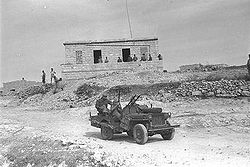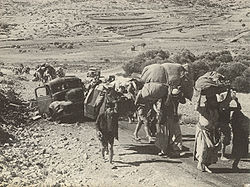- Operation Hiram
-
Operation Hiram Part of 1948 Arab-Israeli War 
IDF soldiers in Sa'sa', 30 October 1948Date October 29, 1948 – October 31, 1948 Location Upper Galilee, Israel Result Israel captures the Upper Galilee Belligerents  Israel
Israel
7th Armoured Brigade
Carmeli Brigade
Golani Brigade
Oded Brigade Arab Liberation Army
Arab Liberation Army
Commanders and leaders  Moshe Carmel
Moshe Carmel Fawzi al-Qawuqji
Fawzi al-QawuqjiCasualties and losses 50,000 Palestinian refugees Operation Hiram was a military operation conducted by the Israel Defense Forces (IDF) during the 1948 Arab-Israeli War. It was led by General Moshe Carmel, and aimed at capturing the upper Galilee region from the Arab Liberation Army (ALA) forces led by Fawzi al-Qawuqji and a Syrian battalion.[1] The operation, which lasted just 60 hours (October 29-October 31) ended just before the ceasefire with the neighboring Arab countries went into effect. The result ensured that the Upper Galilee, originally slated by the United Nations partition plan to be part of the Arab state, would be controlled by the newly formed state of Israel, and that more than 50,000 new Palestinian refugees would leave for Lebanon.[2]
Contents
Overview
On September 26, 1948, Ben-Gurion told his cabinet that if fighting should be renewed in the north, then the Galilee would become "clean" [naki] and "empty" [reik] of Arabs, and implied that he had been assured of this by his generals.[3]
The operation was launched on the night of 28/29 October 1948, fielding four IDF brigades, the Seventh, Carmeli Brigade, Golani, and the Oded Brigade. The operational order was "to destroy the enemy in the central Galilee "pocket", to occupy the whole of the Galilee and to establish the defense line on the country´s northern border."[2] On October 29, Weitz, learning about the start of the operation, sent Yigael Yadin a note urging that the army should expel the "refugees" from the newly conquered areas.[4]
The Ground offensive was preceded by bombing raids targeting Tarshiha, Jish and Sa'sa from the 22 October, using B-17s and C-47s (converted for bombing role). The heaviest night of bombing was 29/30 October when 13 missions dropped 21 tons of bombs on the seven villages. The bombardment of Tarshiha triggered the mass flight after 24 of the inhabitants were killed and approximately 60 were buried under rubble.[5]
The initial thrust was carried out by the Seventh Brigade advancing from Safad. The Seventh Brigade occupied Qaddita on 29 October, Meirun and then Safsaf and Jish. In the 79th Battalion's report, the battles for Safsaf and Jish were described as "difficult" and "cruel" (achzari). One IDF report said "150-200" Arabs, "including a number of civilians" died in the battle for Jish,[6] while after Safsaf had been captured, brigades committed the Safsaf massacre,
From Jish, the 72nd and 79th battalions then turned west to take Sa'sa. After taking Sa'sa the Israeli forces then turned northwest taking Kfar Birem, Saliha and by the afternoon of the 30 October were at al Malikiya.[5]
Simultaneously, the Golani Brigade engaged in diversionary tactics in the direction of the village of Illaboun. The Carmeli Brigade, which was assigned to counter attacks from Syria and Lebanon, crossed the border into Lebanon, captured 15 villages, and reached the Litani River.[7]
Ceasefire was scheduled to commence at 11:00 hours, October 31, 1948. The same day, at 7:30 in the morning, Major General Moshe Carmel ordered his brigades and district commanders "to continue the cleansing operations inside the Galilee". In a cable dated 10:00 hours the same day Carmel ordered his brigades and district commanders: "Do all in your power for a quick and immediate cleansing [tihur] of the conquered areas of all the hostile elements in line with the orders that have been issued[.] The inhabitants of the areas conquered should be assisted to leave." This order was apparently issued after Carmel had met with Ben-Gurion the same day.[8]
On 31 October and 1 November 1948 the Hula massacre took place at Hula (Hule). The village had been captured on October 24 by the Carmeli Brigade without any resistance at all. Between 35 and 58 captured men were reportedly shot down in a house which was later blown up on top of them.[9]
At the end of this lightning attack, Israeli forces reached the Hiram Junction, north of Safed. The siege of Manara was lifted, Qawuqji's army fled to Lebanon, and the roads crossing the Upper Galilee were secured. With the Galilee under Israeli control, the IDF established a defensive line along the Litani before withdrawing to the Lebanese border under the terms of the 1949 Armistice Agreements.
The Israeli Air Force bombings caused considerable damage to the villages in the area. Ilan Pappe gives the example of the four villages: Rama, Suhmata, Malkiyya and Kfar Bir'im. He states that out of the four 'the only village to remain intact was Rama. The other three were occupied and destroyed'.[10] Very few villagers were allowed to stay in their homes and many were imprisoned or expelled to Lebanon and elsewhere. Ilan Pappe claims that the 'Hebrew noun tihur (cleansing) assumed new meanings' during this time period. He argues that although 'it still described, as before, the total expulsion and destruction of a village, it could now also represent other activities, such as selective search and expulsion operations'.[11]
The name is a reference to Hiram I, the Biblical king of Tyre. He was instrumental in the construction of the First Temple of Jerusalem.
Massacres
Main article: Killings and massacres during the 1948 Palestine WarAround 10 massacres occurred during this operation.
According to Morris, the atrocities committed during Operation Hiram clearly embarrassed the IDF and Israeli officials who were soon forced to respond to Arab and UN charges in various forums. The main official Israeli response was a flat or qualified denial that atrocities had taken place.[12]
Arab communities captured in Operation Hiram
Name Population
1945 census[13]Date Resistance Brigade Massacre Al-Nabi Rubin Early October 1948 none n/a Mirun 290 October 29, 1948 militia 'company' 7th Brigade
Carmeli BrigadeSafsaf 910 October 29, 1948 ALA 2nd Battalion 7th Brigade[14] see Safsaf massacre Jish October 29, 1948 Syrian battalion 7th Brigade[14] 10 POWs + "a number of" civilians[14] Sa'sa 1,130 October 30, 1948 none 7th Brigade
Druze unitAlleged killings of civilians. However, the relevant files remain closed to historians.[15] Suhmata October 30, 1948 none Golani Brigade Dayr al-Qassi 2,300 October 30, 1948 none n/a Dayshum 590 October 30, 1948 N/A 7th Brigade Eilabun October 30, 1948 ALA force Golani see Eilabun massacre Fara 320 October 30, 1948 N/A 7th Brigade al-Farradiyya 670 October 30, 1948 N/A Golani Brigade Ghabbatiyya 60 October 30, Arab Liberation Army N/A Kafr 'Inan 360 October 30, 1948 none Golani Brigade Marus October 30, 1948 none 7th Brigade al Ras al Ahmar 620 October 30, 1948 'empty' 7th Brigade Sabalan, Safad 70 N/A Golani Brigade Saliha 1,070 30 October 1948 none 7th Brigade[14] Documented 60-94 killed [16] Kafr Bir'im 710 October 31, 1948 'surrendered' N/A Arab al-Samniyya 200 October 30–31, 1948 none 7th, Carmeli, Golani, Oded Iqrit 490 October 31, 1948 none Oded Brigade Iribbin, Khirbat 360 October 31, 1948 none Oded Brigade Hula October 31, 1948 see Hula massacre Al-Mansura, Acre 2,300 October 1948 N/A N/A Tarbikha 1,000 end of October 1948 none Oded Brigade Suruh November 1948 none ? Brigades participating in Operation Hiram
- Carmeli Brigade
- Golani Brigade
- Sheva' Brigade
- Oded Brigade
See also
- The Deportations of the Hiram Operation: Correcting a Mistake
References
- ^ Institute for Palestine Studies Morris, Benny "Operation Hiram Revisited: A Correction" in 28, no. 2 (Win. 99): 68-76.
- ^ a b Morris (2004), p 473
- ^ Morris (2004), p 463
- ^ Morris (2004), p 463-464
- ^ a b Morris (2004) page 473
- ^ Morris (2004) page 473, 474
- ^ Morris (2004) page 474
- ^ Morris (2004), p 464
- ^ Morris (2004), p.481, 487, 501, 502.
- ^ Pappe (2006), page 181
- ^ Pappe (2006), page 182
- ^ For examples, see Spector to Baruck, 12 Nov. 1948, in which the IDF liaison officer, Spector, reports to his commander: "In relation to the 13 killed [in the Eilabun massacre ], I proved [sic] that the army was not in the village at the time...." Cited in Morris (2004), p. 481, 501
- ^ 'All That Remains'. ISBN 0 88728 224 5. (1992).
- ^ a b c d Morris (2004), p.481
- ^ Morris (2004), p. 481, 501, 503.
- ^ Morris, p. 487
Bibliography
- Walid Khalidi (Editor), 'All that remains : the Palestinian villages occupied and depopulated by Israel in 1948.' (1992). Institute of Palestine Studies. ISBN 0 88728 224 5.
- Benvenisti, Meron (2000). Sacred Landscape: The Buried History of the Holy Land Since 1948. University of California Press. ISBN 0-520-21154-5,
- Morris, Benny (2004). The Birth of the Palestinian Refugee Problem Revisited Cambridge: Cambridge University Press. ISBN 0-521-00967-7
- Nazzal, Nafez (1978): The Palestinian Exodus from Galilee 1948, The Institute for Palestine Studies, (Safsaf, p. 93-96, 107)
- Ilan Pappé (2006) The Ethnic Cleansing of Palestine Oneworld publications ISBN 9781851684670
External links
Israeli military operations in the 1948 Arab-Israeli War Pre-IDF IDF Categories:- Battles and operations of the 1948 Arab–Israeli War
Wikimedia Foundation. 2010.

